The Ultimate Guide to Visiting Xi’an City Wall: History, Tips, and Attractions
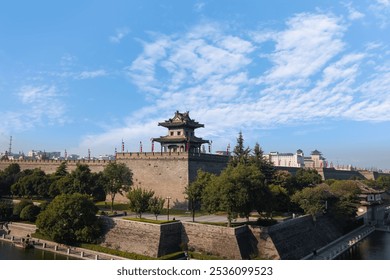
An Essential Guide to Visiting Xian City Wall
In This Guide
- An Essential Guide to Visiting Xian City Wall
- The Rich History and Legends of Xian City Wall
- Main Highlights: What You Absolutely Can’t Miss
- Planning Your Visit: A Practical Guide
- Tickets: Prices, Booking, and Tips
- How to Get There: A Complete Transportation Guide
- Local Cuisine and Accommodation Nearby
- Frequently Asked Questions
- Final Thoughts on Your Trip
Visiting the Xi’an City Wall is akin to stepping back into a vibrant tapestry of Chinese history, where ancient fortifications whisper stories of emperors and warriors. As the largest and best-preserved city wall in all of China, this monumental structure stands as a testament to the ingenuity and resilience of the past, offering visitors a unique glimpse into the rich cultural heritage of Xi’an.
Constructed during the Ming Dynasty, the wall stretches over 13 kilometers, encircling the heart of Xi’an and framing the city’s fascinating blend of history and modernity. With its impressive height of 12 meters and wide walkways, the wall invites you to stroll along its ramparts and take in panoramic views of the bustling city below.
Why Visit the Xi’an City Wall?
The Xi’an City Wall is not just a historical site; it is a living monument that enchants with its architectural grandeur. Walking along the wall, you will encounter ancient military installations, including watchtowers, archery towers, and crenels—each piece echoing the strategic military significance of its time. The four main gates—Yongning, Anding, Anyuan, and Changle—each hold their own stories, waiting to be discovered.
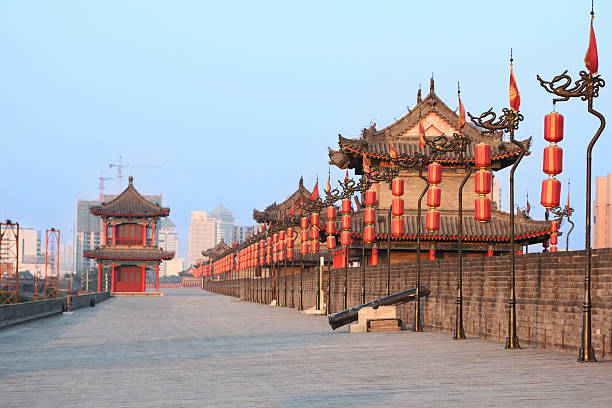
Xian_City_Wall.
Whether you are a history buff, a lover of architecture, or simply a curious traveler, the Xi’an City Wall offers a profound experience. As you explore, you will not only witness the remnants of a bygone era but also appreciate the cultural significance of this remarkable structure in shaping the identity of Xi’an.
Join us as we delve into the essential aspects of visiting the Xi’an City Wall, where every brick tells a story and each corner beckons with intrigue.
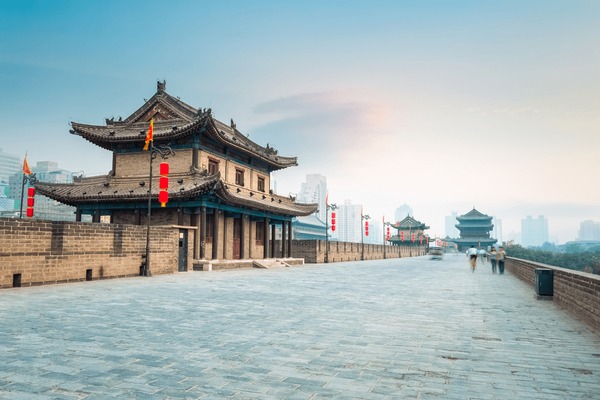
Xian_City_Wall.
The Rich History and Legends of Xian City Wall
The Xi’an City Wall stands as a monumental testament to China’s rich historical tapestry, weaving together stories of ancient emperors, military might, and the cultural evolution of one of the country’s most significant cities. This magnificent structure is not just a defensive fortification; it encapsulates centuries of historical significance and legendary tales that continue to resonate today.
A Historical Overview
Constructed initially during the Sui Dynasty in 583 AD, the Xi’an City Wall is the largest and best-preserved ancient city wall in China. It was built to replace the remnants of the earlier Han Dynasty city, which had been ravaged over time. As the capital during the Sui and Tang Dynasties, Xi’an flourished, becoming a vibrant hub of trade and culture. However, the wall we see today primarily reflects the extensive renovations carried out during the Ming Dynasty (1368-1644), a period when the need for fortified defenses was paramount.

Xian_City_Wall.
The construction of the wall involved meticulous planning and architectural innovation, stretching approximately 13.74 kilometers around the city. Standing 12 meters high and 12-14 meters wide, it was designed not only to repel invaders but also to symbolize the strength and unity of the Chinese nation. Over the years, the wall underwent several phases of construction, with distinct changes in materials and design reflecting the eras they were built in—from the thickened walls of the Tang Dynasty to the brickwork of the Ming.
Legends and Folklore
The Xi’an City Wall is steeped in legends that add a layer of intrigue to its historical significance. One tale speaks of the Southwest Watchtower, a unique circular structure that stands apart from the square towers of the other three corners. Local lore suggests that this design change was a reminder of a tragic story: during the Ming Dynasty, a cruel son and daughter-in-law were punished for their misdeeds at this location. To symbolize their dishonesty, the originally planned square design was altered to a circle, marking their legacy in the city’s history.
Another fascinating aspect lies in the numbered bricks found along the walkway of the wall. These numbers, reminiscent of modern QR codes, were implemented during restoration efforts in the 1980s to track the bricks and ensure proper repairs. This method highlights the ingenuity of the workers and serves as a tangible link between the past and present.

Xian_City_Wall.
Architectural Marvels and Cultural Significance
The wall features a series of gates, each imbued with its own history and significance. The Yongning Gate, also known as the South Gate, dates back to 582 AD and has witnessed countless historical events. Meanwhile, the Anding Gate on the west side served as a military headquarters during the Ming Dynasty, highlighting the strategic importance of this fortification.
The Changle Gate, or East Gate, symbolizes the hope for prosperity and joy, while the Anyuan Gate reflects the Ming Dynasty’s conciliatory policies towards ethnic minorities in the north. Each gate not only served a defensive purpose but also played a role in the cultural and social life of the city.

Xian_City_Wall.
Beyond its military function, the moat surrounding the wall has a dual purpose. Originally designed to thwart invaders, it now serves as an essential drainage system, showcasing the practical wisdom of ancient Chinese engineering.
A Living Legacy
Today, the Xi’an City Wall is more than a relic of the past; it is an active cultural landmark that draws visitors from around the globe. It serves as a backdrop for various cultural festivals and celebrations, allowing travelers to experience the vibrant heritage of Xi’an firsthand. Walking atop the wall, visitors can admire breathtaking views of the city, intertwining the ancient and modern landscapes.
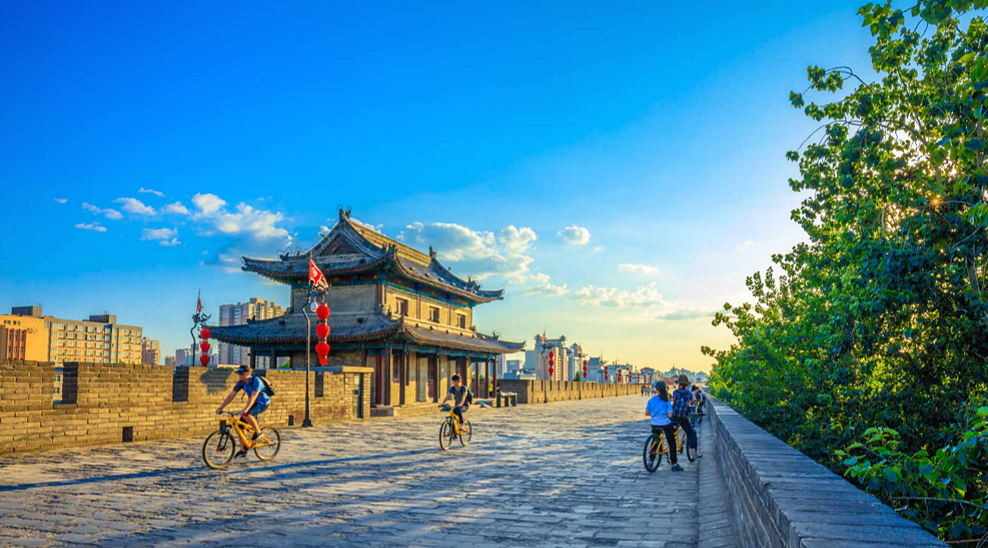
Xian_City_Wall.
To fully appreciate the depth of history and the myriad legends associated with the Xi’an City Wall, one might consider joining guided tours that delve deeper into its architectural details and historical narratives. Engaging with local historians and storytellers can unveil the fascinating tales that continue to shape the identity of Xi’an today.
In this way, the Xi’an City Wall stands not only as a symbol of defense but as a bridge connecting the rich historical fabric of China with the present, ensuring that the stories of its past are never forgotten.

Xian_City_Wall.
Main Highlights: What You Absolutely Can’t Miss
Discover the Majestic Xi’an City Wall: Key Highlights You Can’t Miss
The Xi’an City Wall stands as a testament to China’s rich historical tapestry, offering visitors a unique glimpse into the architectural prowess and military strategies of ancient China. As the largest and best-preserved ancient city wall in the country, a visit here is a journey through time, where each stone has a story to tell. Below are the essential highlights that you absolutely cannot miss when exploring this monumental fortification.
1. Yongning Gate (南门) – The Historical South Gate
- Significance: As the oldest gate of the city wall, built in 582 AD, Yongning Gate is a significant historical landmark. Initially named Anshang Gate, it has witnessed centuries of history and transformation.
- Features: Although the archery tower was destroyed in the 1920s, visitors can still admire the formidable structure and imagine the defenses that once stood here.
2. Anding Gate (西门) – The West Gate Fortress
- Architecture: Anding Gate is a remarkable example of ancient military architecture, featuring a complete ancient castle structure, including a barbican and an arrow tower.
- Historical Role: Originally known as Shunyi Gate, it served as a military headquarters during the Ming Dynasty, making it a fascinating site for history enthusiasts.

Xian_City_Wall.
3. Anyuan Gate (北门) – The North Gate
- Cultural Importance: Built during the Ming Dynasty, Anyuan Gate embodies the conciliatory policies toward the northern ethnic minorities at the time.
- Restoration: After suffering damage during the 1911 Revolution, it was restored in 1983, allowing visitors to appreciate both its historical significance and architectural beauty.
4. Changle Gate (东门) – The East Gate of Prosperity
- Historical Context: Changle Gate, meaning “Long-lasting Joy,” is one of the oldest gates that has undergone several reconstructions, reflecting the resilience of the city through turmoil.
- Visitor Experience: The gate allows visitors to explore the rich history and the architectural evolution that has taken place over centuries.

Xian_City_Wall.
5. The Moat – A Remarkable Engineering Feature
- Functionality: Originally designed as a defensive barrier, the moat now also serves as an effective drainage system, showcasing the ingenuity of ancient engineering.
- Scenic Views: Strolling along the moat offers picturesque views of the city wall, making it a perfect backdrop for photographs.
6. Watch Towers and Archery Towers
- Defense Mechanisms: The city wall features several watch towers and archery towers, strategically placed for surveillance and defense. The unique design of each tower reflects the military architecture of the Ming Dynasty.
- Architectural Features: The archery towers, with their multiple floors and arrow slots, allowed defenders to fend off attacks effectively, highlighting the wall’s defensive capabilities.
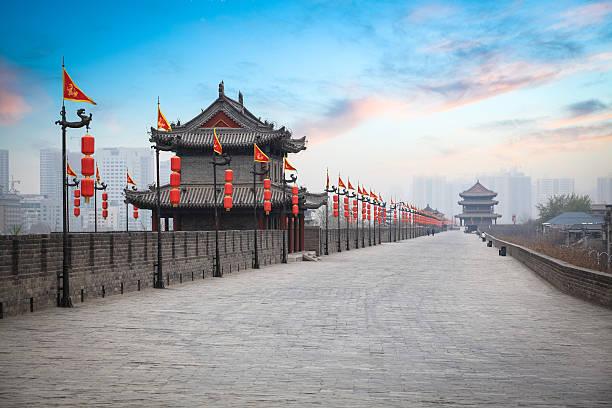
Xian_City_Wall.
7. The Parapet Wall and Crenels
- Defensive Design: The parapet walls, adorned with crenels, were essential for protection against invaders. With nearly 6,000 crenels, they exemplify the strategic design of the city wall.
- Visitor Engagement: Walking along the top of the wall, visitors can fully appreciate these architectural details while enjoying sweeping views of Xi’an.
8. Kuixing Tower – The Learning Sanctuary
- Cultural Symbolism: Dedicated to Kuixing, the god of literature, this tower stands as a tribute to the importance of education in Chinese culture.
- Architectural Splendor: Built in 1619, the tower’s intricate designs and steep roofs make it a stunning sight, perfect for a leisurely visit.
9. Unique Corner Towers
- Distinct Architecture: The city wall’s corner towers, particularly the unique southwest watchtower, provide insight into the architectural variations that have evolved over time.
- Historical Lore: Each corner tower has its own tale, adding layers of cultural significance to the structure.
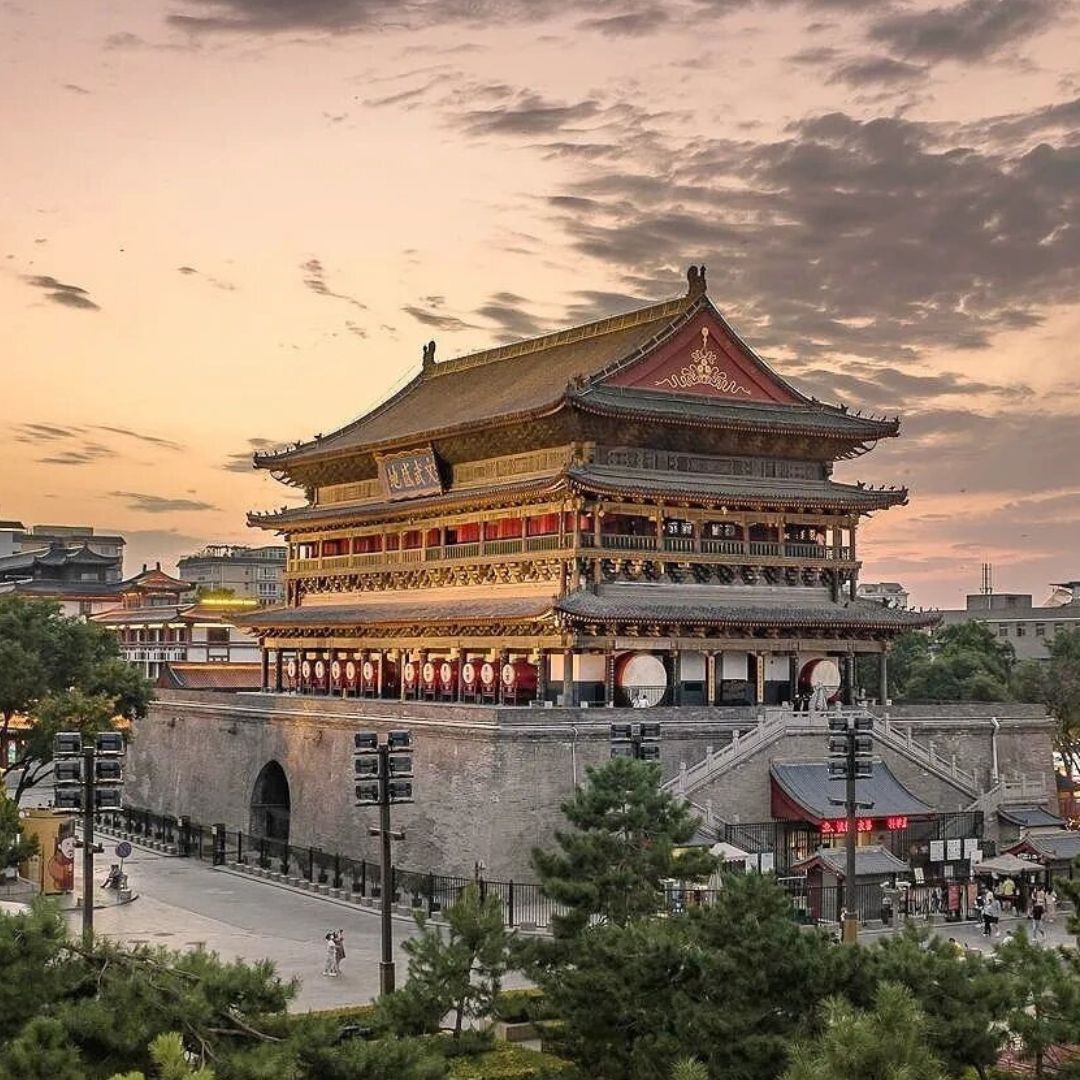
Xian_City_Wall.
10. Guided Tours for an In-Depth Experience
To truly grasp the historical and architectural richness of the Xi’an City Wall, consider joining a guided tour. Knowledgeable guides can share captivating stories and insights that bring the wall’s past to life, enhancing your understanding and appreciation of this magnificent structure.
Conclusion
A visit to the Xi’an City Wall is an immersive experience that blends history, culture, and stunning architecture. Each gate, tower, and pathway tells a story that connects visitors to the ancient past of China. Don’t miss the opportunity to walk along this monumental fortification and explore the stories etched in its stones. Whether you’re a history buff or simply a traveler seeking to understand the depths of Chinese culture, the Xi’an City Wall promises a memorable adventure.
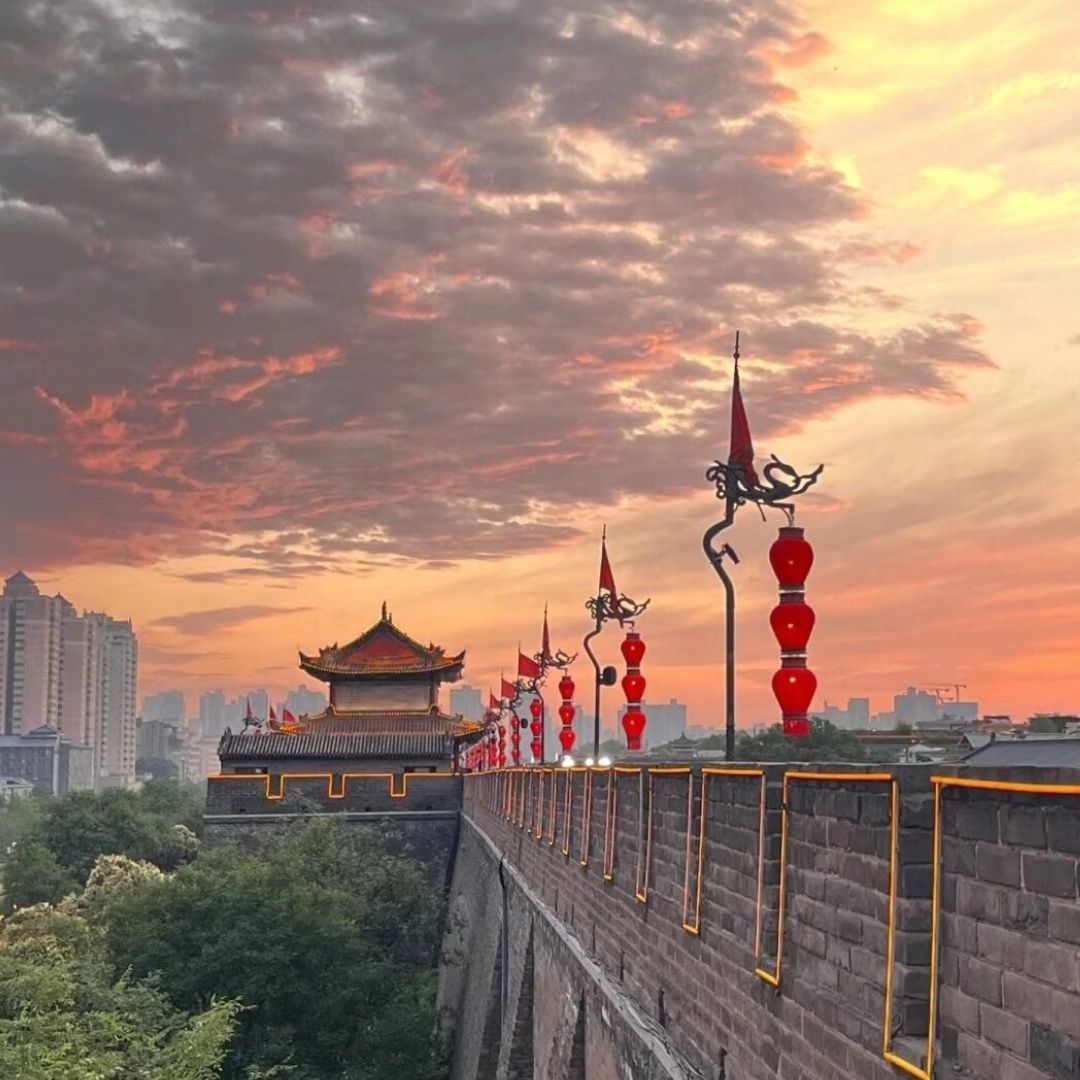
Xian_City_Wall.
Planning Your Visit: A Practical Guide
Your Gateway to Xi’an City Wall: A Practical Guide
Visiting the Xi’an City Wall is not just a journey through time; it is an immersive experience that connects you with the rich history and culture of one of China’s most significant ancient capitals. Here’s a comprehensive guide to help you make the most of your visit.
Location and Access
- Address: The wall is centrally located in Xi’an, with its main entrance at Yongning Gate on No. 2 Beilin South Street.
- Getting There: You can easily reach the wall via public transportation, including buses and the Xi’an subway. Taxis are also readily available throughout the city.
Opening Hours
- Yongning Gate (South Gate): 08:00 AM – 10:00 PM
- Zhongshan Gate: 08:00 AM – 09:00 PM
- Changle Gate (East Gate), Anding Gate (West Gate), Anyuan Gate (North Gate), Wenchang Gate: 08:00 AM – 06:00 PM
Admission Fees
- Ticket Price: CNY 54 per adult. Discounts may be available for students or seniors, so be sure to inquire!
Best Times to Visit
- Ideal Seasons: The best times to explore the wall are during the spring (March to June) and fall (September to November) when the weather is mild and pleasant.
- Avoiding Crowds: Early mornings or late afternoons are ideal for a quieter experience, especially during weekends or public holidays.
Duration of Visit
- Time Needed: Allocate 1 to 3 hours for your visit, depending on how much of the wall and its features you wish to explore.
What to See
The Xi’an City Wall is rich with historical features and stunning architecture. Here are some highlights:
- The Four Main Gates:
- Yongning Gate (South Gate): The oldest gate, dating back to 582 AD.
- Anding Gate (West Gate): A well-preserved example of ancient military architecture.
- Anyuan Gate (North Gate): Known for its historical significance during the Revolution of 1911.
-
Changle Gate (East Gate): A symbol of prosperity and resilience.
-
Watch Towers and Archery Towers: These structures provide insight into the defensive strategies of ancient Xi’an.
-
Parapets and Crenels: Walk along the top of the wall and enjoy the views while learning about the defensive features that protected the city.
-
Turrets: Visit the corner towers for an expansive view of the surrounding area and to appreciate their architectural uniqueness.
-
The Moat: Explore the deep moat that once served as a primary line of defense and now plays a crucial role in flood management.
-
Kuixing Tower: A beautiful structure dedicated to the god of learning, located just east of Yongning Gate.
Tips for Your Visit
- Comfortable Footwear: Wear sturdy shoes, as you’ll be walking on ancient stones and may encounter uneven surfaces.
- Guided Tours: Consider joining a guided tour for an in-depth understanding of the wall’s history and architecture.
- Photography: Bring your camera! The wall offers stunning views, especially at sunrise and sunset.
- Stay Hydrated: Bring water, especially during warmer months, as you may spend a considerable time outdoors.
Cultural Insights
- Historical Significance: Understand that the wall is a symbol of Xi’an’s historical importance as a capital during the Sui and Tang Dynasties.
- Architecture: Note the unique features such as the rounded southwest watchtower, which reflects a fascinating story from history.
Conclusion
Your visit to the Xi’an City Wall is sure to be a memorable experience filled with historical richness and architectural beauty. By planning ahead and knowing what to expect, you can fully appreciate this remarkable monument that has stood the test of time, offering a glimpse into China’s storied past.
Tickets: Prices, Booking, and Tips
When planning your visit to the magnificent Xi’an City Wall, understanding the ticketing process is essential for a seamless experience. Below is a comprehensive guide to ticket prices, booking options, and valuable tips to enhance your journey through this historical marvel.
Ticket Prices
- General Admission: CNY 54 per adult
- Children: Children under 1.4 meters (approximately 4.6 feet) in height can enter for free, but a ticket is required for children above this height.
Opening Hours
To make the most of your visit, be aware of the opening hours for the various gates:
- Yongning Gate (South Gate): 08:00 AM – 10:00 PM
- Zhongshan Gate: 08:00 AM – 9:00 PM
- Changle Gate (East Gate), Anding Gate (West Gate), Anyuan Gate (North Gate), and Wenchang Gate: 08:00 AM – 6:00 PM
Tip: It is advisable to visit in the late afternoon or early evening when the crowds thin out, allowing for a more leisurely exploration.
Booking Options
On-site Purchase: Tickets can be easily purchased at the gates, which is convenient for spontaneous visits. However, during peak tourist seasons, lines may be longer than expected.
Online Booking: For a hassle-free experience, consider booking your tickets in advance through various travel platforms or the official Xi’an tourism website. This option not only saves time but often provides access to special discounts or packages.
Payment Methods
Most ticket counters accept cash, but it is advisable to bring a mobile payment method (like WeChat Pay or Alipay), as these are widely used in China and can expedite your transaction.
Tips for Your Visit
-
Best Seasons: The ideal times to visit the Xi’an City Wall are from March to June and September to November. During these months, the weather is pleasant, making your exploration more enjoyable.
-
Plan Your Route: Consider starting your tour at Yongning Gate, the main entrance for tourists, and then walking along the wall to appreciate the stunning views of the city and its ancient architecture.
-
Guided Tours: For those keen on delving deeper into the history and significance of the City Wall, joining a guided tour can provide a wealth of information and context that enhances your understanding of this incredible structure.
-
Bring Water and Snacks: Exploring the extensive City Wall can be physically demanding, especially during warmer months. Carrying water and light snacks will keep your energy levels up.
-
Photography Opportunities: Don’t forget your camera! The City Wall offers fantastic photo opportunities, especially at sunset when the golden light bathes the ancient stones.
By keeping these ticketing details and tips in mind, you’ll be well-prepared for an unforgettable journey through one of China’s most iconic historical sites. Enjoy your exploration of Xi’an City Wall, where history comes alive!
How to Get There: A Complete Transportation Guide
Navigating Your Way to the Majestic Xi’an City Wall
Xi’an City Wall, an iconic symbol of China’s rich historical tapestry, is conveniently located in the heart of Xi’an, Shaanxi Province. Getting to this magnificent fortification is a straightforward journey, thanks to the city’s well-developed transportation network. Here’s how you can easily make your way to this must-see attraction.
Arriving by Air
Xi’an Xianyang International Airport (XIY) is the primary gateway for international travelers. It is situated about 40 kilometers (25 miles) northwest of the city center.
- Airport Transfer Options:
- Taxi: The most convenient option, taking approximately 1 hour and costing around CNY 100-150.
- Airport Shuttle Bus: A budget-friendly choice, with routes to various city centers, including the downtown area. The fare ranges from CNY 25-30.
- Private Transfer: Many hotels offer pick-up services, which can be pre-arranged.
Getting to the City Wall from the City Center
Once you arrive in Xi’an, reaching the City Wall is easy, given its central location.
-
Walking: If you are staying in the city center, the wall is easily accessible on foot. It’s a pleasant stroll through Xi’an’s bustling streets, taking about 15-30 minutes depending on your starting point.
-
Public Transportation:
- Subway: The Xi’an Metro Line 2 has several stations near the City Wall. Yongning Gate Station is the closest, just a short walk from the south gate. The subway is efficient, clean, and cost-effective, with fares starting at CNY 2.
-
Buses: Numerous local buses serve the area around the City Wall. Look for routes that stop at Yongning Gate, Changle Gate, or any of the other gates. A single bus fare is typically around CNY 1-2.
-
Taxi or Ride-Hailing Services: If you prefer a more direct route, taxis are readily available. A ride from any central location to the City Wall will cost around CNY 15-30. Alternatively, services like Didi (China’s equivalent of Uber) can be convenient for those who prefer mobile apps.
Exploring the City Wall
The City Wall features several gates, each offering unique historical insights and easy access to the wall itself.
- Yongning Gate (South Gate): This is the most popular entrance for visitors, with extended opening hours (08:00-22:00) allowing for evening strolls.
- Changle Gate (East Gate), Anding Gate (West Gate), and Anyuan Gate (North Gate) also provide access, with varied visiting hours.
Tip: Consider renting a bicycle to ride along the top of the wall, a popular activity that allows you to take in the panoramic views of the city.
Best Time to Visit
While the City Wall can be visited year-round, the best seasons are spring (March-June) and autumn (September-November). During these months, the weather is mild, making your exploration of this historic site even more enjoyable.
Final Thoughts
Whether you’re arriving by air or navigating through the city, reaching Xi’an City Wall is a seamless experience that sets the stage for a remarkable journey into China’s past. With its impressive architecture and rich history, a visit to the wall promises to be a highlight of your travels in Xi’an.
Local Cuisine and Accommodation Nearby
Savoring Xi’an: Local Cuisine and Accommodation Options
Visitors to the majestic Xi’an City Wall are not only treated to a glimpse of ancient military architecture but also a rich tapestry of culinary experiences and comfortable accommodations nearby. Whether you’re a history buff or a food enthusiast, the area surrounding the City Wall offers a delightful array of local flavors and charming places to stay.
Culinary Delights
Xi’an is renowned for its vibrant food scene, deeply rooted in its historical significance as a cultural melting pot. Here are some must-try dishes and popular eateries within walking distance of the City Wall:
-
Biang Biang Noodles (油泼面)
Known for their wide, thick texture, these hand-pulled noodles are typically served with a spicy sauce and an array of vegetables. Noodle Bar near Yongning Gate is an excellent spot to experience this local favorite. -
Roujiamo (肉夹馍)
Often referred to as a Chinese hamburger, this snack features tender, braised meat stuffed in a fluffy flatbread. Old Wang’s Roujiamo is a beloved eatery where you can savor this delectable dish. -
Yangrou Paomo (羊肉泡馍)
This hearty lamb soup served with crumbled flatbread is a Xi’an specialty. Head to De Fa Chang for an authentic taste, where the rich broth is complemented by high-quality ingredients. -
Shaanxi-style Dumplings (饺子)
Dumplings in Xi’an are often larger and filled with various meats and vegetables. Dumpling Banquet Restaurant offers an extensive menu of beautifully crafted dumplings, perfect for those looking to indulge. -
Cold Noodles (凉皮)
For a refreshing option, try these cold, chewy noodles dressed in a tangy sauce with cucumbers and garlic. Yangguang Cold Noodle Shop is a local favorite, known for its authentic flavors.
Where to Stay
After a day of exploring the ancient walls and tantalizing your taste buds, finding a comfortable place to rest is essential. Here are some recommended accommodations near the Xi’an City Wall:
-
Sofitel Legend People’s Grand Hotel Xi’an
This luxurious hotel offers a blend of modern amenities and traditional Chinese charm. Located just a short stroll from the City Wall, it provides a lavish stay with exquisite dining options. -
Grand Park Xian
Situated conveniently near the City Wall, this hotel features well-appointed rooms and a lovely garden. It’s an excellent choice for families and business travelers alike, offering both comfort and convenience. -
Xi’an City Wall Hotel
For those who want to immerse themselves in the history of Xi’an, this hotel is located right next to the City Wall. It combines contemporary comfort with a historical ambiance, making it a unique place to stay. -
Hanting Express
If you’re looking for budget-friendly options without sacrificing quality, Hanting Express offers clean and comfortable accommodations. Its prime location allows easy access to various attractions, including the City Wall.
Conclusion
Exploring the Xi’an City Wall is a journey through time, and pairing this experience with the city’s rich culinary offerings and accommodating lodgings enhances your visit. Whether you’re indulging in local dishes or resting in a nearby hotel, Xi’an promises a memorable adventure that beautifully intertwines history and culture.
Frequently Asked Questions
Frequently Asked Questions about Xi’an City Wall
1. What is the significance of Xi’an City Wall?
The Xi’an City Wall is not only the largest and best-preserved ancient city wall in China but also a symbol of Xi’an’s rich history. Built originally during the Sui Dynasty, it has undergone numerous renovations, particularly during the Ming Dynasty, making it a pivotal part of the city’s defensive architecture and cultural heritage.
2. How tall and wide is the Xi’an City Wall?
The wall stands approximately 12 meters (39.4 feet) high and has a top width ranging from 12 to 14 meters (13 to 15.3 yards). Its impressive structure is designed to provide stability and defense, making it a remarkable feat of ancient engineering.
3. What are the main gates of the city wall?
Xi’an City Wall features four main gates:
– Yongning Gate (South Gate)
– Changle Gate (East Gate)
– Anding Gate (West Gate)
– Anyuan Gate (North Gate)
Each gate has its unique history and architectural features, playing a crucial role in the city’s defense system.
4. How much time should I allocate for a visit?
Visitors typically spend 1 to 3 hours exploring the city wall. This allows ample time to walk along the top, visit the various gates and towers, and enjoy the stunning views of Xi’an.
5. What are the opening hours for the city wall?
The opening hours vary by gate:
– Yongning Gate (South Gate): 08:00 – 22:00
– Zhongshan Gate: 08:00 – 21:00
– Changle Gate (East), Anding Gate (West), Anyuan Gate (North), and Wenchang Gate: 08:00 – 18:00
6. Is there an entrance fee for the Xi’an City Wall?
Yes, the entrance fee is CNY 54 per adult. This ticket grants you access to walk along the wall and explore its many features.
7. What are the best times of year to visit?
The ideal seasons for visiting Xi’an City Wall are March to June and September to November. During these months, the weather is pleasant, making it enjoyable to walk along the wall and take in the scenery.
8. Are there guided tours available?
Yes, guided tours are available, providing an in-depth exploration of the city wall’s history and architecture. These tours can enhance your experience by offering unique insights and stories about this historic structure.
Final Thoughts on Your Trip
As you wrap up your visit to Xi’an City Wall, take a moment to reflect on the echoes of history surrounding you. This remarkable fortification, with its towering walls and intricate architecture, stands as a testament to the resilience and ingenuity of ancient Chinese civilization. Here are a few thoughts to inspire your journey:
A Living History
Walking along the city wall, you’re not just traversing a physical structure; you are stepping into the past. Each brick, some etched with numbers from restoration efforts, tells a story of defense, survival, and community. The wall has witnessed centuries of change—wars, dynasties, and cultural shifts—each leaving its mark.
Architectural Marvel
Marvel at the impressive engineering that has allowed the wall to withstand the test of time. The unique design, with its wider base and strategic features like watchtowers and crenels, showcases the sophistication of ancient military architecture. The preservation of this structure allows you to appreciate the artistry and thoughtfulness of those who built it.
Cultural Significance
Xi’an City Wall is more than just a historical site; it is a symbol of the spirit and identity of Xi’an. The wall encapsulates the essence of the city’s rich heritage, reminding visitors of its role as a cultural crossroads throughout history. As you gaze out over the city from its heights, consider how this ancient fortification has shaped the lives of countless generations.
Final Reflections
As you conclude your exploration, take a moment to soak in the panoramic views and the vibrant life that pulses within the city it protects. Whether you ventured here for the history, the architecture, or simply the experience of standing where the past meets the present, the Xi’an City Wall invites you to carry its stories with you.
Embrace the memories you’ve made during your visit and let them inspire your next adventure. Every corner of Xi’an has tales to tell, and the City Wall is only the beginning of your journey through this extraordinary city. Safe travels!